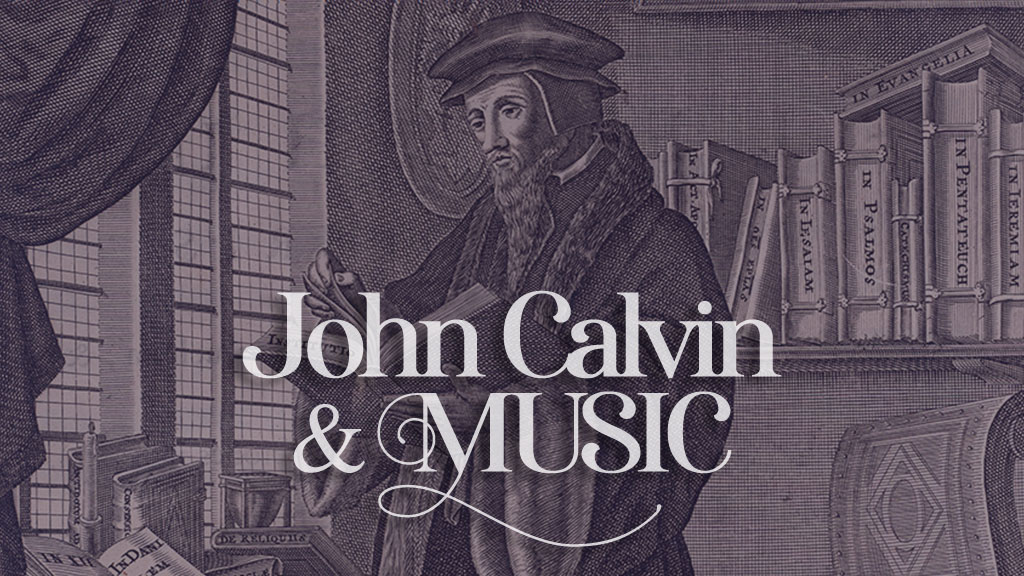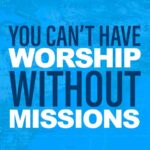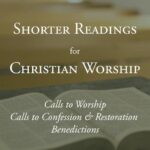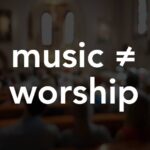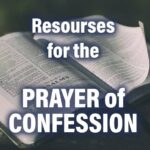John Calvin’s views on music can be found in his 1543 “Letter to the Reader,” his Institutes 3.20.31–32, and his commentaries on Colossians 3 and 1 Corinthians 14.
In a recent article published in the Calvin Theological Journal, I argue that Calvin’s reliance on early Christian writers in the promotion of singing reveals that early Christian writers of the first five hundred years of Christianity were Calvin’s primary source (outside of Scripture) in the formation of his perspectives on singing. The content that follows is selected from the introduction and conclusion of this paper. (For more on this paper, see my post on Academia.)
Calvin—Curmudgeon or Careful Pastor?
John Calvin’s belief that music should be “regulated” or “moderated” due to its potential to be a “deadly and devilish poison” may cause some to view this sixteenth-century French theologian and pastor as an ill-tempered curmudgeon or a pessimistic killjoy.[1] But as Jeremy Begbie has noted, “swift dismissals of Calvin are disingenuous in any field, and that certainly applies here [to music].”[2] Examining Calvin’s use of early Christian sources is essential for discovering what Begbie calls a “nuanced and thought-provoking approach to music.”[3]
To demonstrate more broadly the influence of early Christian writers on Calvin, one can look to his worship practice and the rationale he provides for these practices. He expressly states that the purpose of his liturgy, La forme des prières et chantz ecclésiastiques (The Form of Prayers and Songs of the Church, 1542), is to follow “the practice of the ancient church” (“la coustume de l’Eglise ancienne”).[4] The influence of the fathers on Calvin’s views is also manifested in his application of their writings in his polemic against the use of images when he appeals to “the authority of the ancient church” of the “first five hundred years” of Christian history.[5] While much work has been done to demonstrate the significance of early Christian sources in Calvin’s writings on a variety of topics, this article will examine Calvin’s use of the fathers in an overlooked area—singing. I will argue that early Christian writers were Calvin’s primary source (outside of Scripture) in the formation of his perspectives on singing and specifically his practice of psalm-singing. My research will mainly focus on Calvin’s use of early Christian sources to promote congregational singing, but I will also briefly consider his use of the fathers to support his views on music outside of the church.[6]
Why Calvin, Music, and Early Christian Writers?
Calvin was not the only Protestant Reformer who consulted early Christian sources for support. In fact, most of the Reformers referred to the writings of the fathers.[7] These early Christian authors had been highly revered by the Church since the time of the sixth-century Benedictines, and by the twelfth century, medieval theologians such as Peter Lombard (1096–1160) and Thomas Aquinas (1225–1274), as well as monastic communities who copied and distributed early Christian writings, made the fathers accessible to medieval religious and academic communities. While Calvin’s use of the fathers was not uncommon, neither were his views concerning the regulation of music. Humanist scholars including Desiderius Erasmus (1466–1536), who predated the Reformation by a generation and greatly influenced Calvin and other Reformers, used early Christian writers to critique the Catholic Church’s music. Chiara Bertoglio notes that Erasmus’s views on music were “representative of the humanist movement.”[8] In other words, Erasmus would have agreed with Calvin’s opinion that music should be regulated.
If neither Calvin’s use of the fathers nor his views on music were unique, then what is the benefit of exploring his use of early Christian writers to promote singing? A study of Calvin’s use of the fathers to promote church singing demonstrates his attempts to counter the medieval Church by using their own trusted early Christian sources. Breaking away from the medieval Church’s practice of singing in Latin to singing metrical psalms in the vernacular was not an easy change for the Reformers; it would be a decades-long process for Calvin and the other Reformers. As Karin Maag has noted, “The practice of singing metrical psalms in worship had to be taught: it was not obvious or self-evident to those who were meant to take part.”[9] Calvin’s appeal to early Christian writers served to tether his convictions on the use of metrical psalms for congregational singing to the reliable foundation of the early Christian church. He wanted his congregants and readers to know that his reforms were “nothing of recent invention.”[10]
We should also trace Calvin’s use of early Christian sources to promote church singing because Calvin’s reforms in singing influenced other spheres of society outside of the church in Geneva and had a sweeping impact in multiple languages across Europe. By the late 1500s, psalm-singing became part of everyday life all over France in villages and in the countryside, in prisons and in schools. Tunes original to the Psalter became “battle psalms” for French Huguenot soldiers, and composers incorporated these tunes in their works.[11] The Genevan Psalter was translated into English in 1562, the Dutch version was published in 1565, and the Psalter was completed in German by 1573.[12] Walter Hilbrands provides dates for subsequent translations very soon after the death of Calvin: “Other translations followed shortly thereafter: Italian (1603), Polish (1600/1605), Spanish (1606), Hungarian (1607) and Czech (1587/1618), until the Psalter had been translated into 22 different languages.”[13] To fully appreciate the legacy of Calvin’s Psalter and to understand his approach for tethering his views on music to the fathers, modern readers must understand his use of early Christian sources to support his views on singing.
A Review of the Literature on Calvin and Music
Notwithstanding the impact of Calvin’s Psalter and the early Christian sources that provided the foundation for his views on music, there has been no thorough examination of his use of early Christian writers to promote singing. Liturgists and music scholars who have dealt with Calvin omit the subject of his use of the fathers. Perhaps the most helpful recent resource on Calvin’s worship is Karin Maag’s Lifting Hearts to the Lord, but due to the nature of this work, there is no treatment of his use of the fathers.[14] Terry Johnson advocates for the general importance of the fathers in Calvin’s writings and provides an excellent overview of early Christian psalmody and hymnody, but does not deal with Calvin’s specific use of the fathers for singing.[15] Daniel Hyde deals with the early Christian roots of Calvin’s liturgy but does not examine singing in detail.[16] Emile Doumergue, Oskar Soehngen, and John Witvliet do not interact with Calvin’s use of early Christian writers.[17]
The historian who has provided the most thorough treatment of Calvin’s music is Charles Garside Jr. (1928–1987).[18]Garside does not give an in-depth treatment of Calvin’s use of early Christian writers, but he does provide a commentary and translation of the preface in the 1543 Genevan Psalter and a commentary on the portion of the Institutes that deals with singing.[19] Among recent worship scholars, Jeffrey VanderWilt and Joel Beeke interact with Garside’s content the most, but neither deals specifically with Calvin’s use of the fathers.[20] Garside’s research is nearly matched by Jeremy Begbie who has also provided a thoughtful treatment of Calvin’s music. Since Begbie’s primary concern is the place of Calvin’s musical thought and practices within the rise of modernity, he does not examine Calvin’s use of sources such as Augustine, Chrysostom, and Ambrose. In Reforming Music (2017), Chiara Bertoglio provides an excellent and thorough examination of the Reformers’ perspectives on music and the musical influences of the era. Her monograph may be the most important recent work on the music of the Reformation, but while Bertoglio broadly covers the early Christian influence on Calvin and the Reformers, the nature of her work does not allow for the kind of thorough treatment that my research provides.[21]
In early Christian studies, scholars that deal with Calvin and early Christian sources also overlook themes such as music, song, and singing. William Todd, who was among the first to catalog Calvin’s use of the fathers, does not mention singing, song, or music.[22] In Anthony Lane’s work, there is one passing reference to singing, and there are no references to music or song.[23] Johannes Van Oort’s chapter on Calvin’s use of the fathers in the large collection edited by Irena Backus on the reception of the fathers in the West does not mention singing, song, or music.[24] S. J. Han’s recent topical analysis of Calvin’s use of Augustine does not consider the expanded 1543 “Letter to the Reader” from the Genevan Psalter in which Calvin references Augustine six times to promote singing. Thus, there is no reference to singing, song, or music in Han’s analysis.[25]
Article Purpose and Thesis
To summarize, scholars with an interest in early Christian sources in Calvin’s writings do not discuss singing; liturgical and music scholars do not deal extensively with Calvin’s use of the fathers. To address this gap, this article will argue that Calvin’s reliance on early Christian writers in the promotion of singing, as seen in his 1543 “Letter to the Reader,” his Institutes 3.20.31–32, and his commentaries on Colossians 3 and 1 Corinthians 14 reveals not only Calvin’s deliberate attempts to nurture continuity between the church in Geneva during his ministry and the church of the first five hundred years of Christianity, but also that early Christian writers were Calvin’s main source (outside of Scripture) in the formation of his perspectives on singing.
For more on this paper, see my post on Academia.
Paper Conclusion—John Calvin’s Views on Music
Exploring Calvin’s use of early Christian writers and his perspective on the history of early Christianity is vital for understanding Calvin’s views on singing. Because Calvin’s use of the fathers to promote singing is an overlooked topic among scholars, I have attempted to assess to what extent the fathers influenced Calvin’s views on singing in his ‘Letter to the Reader,” the Institutes 3.20.31–32, and in his commentaries on 1 Corinthians 14 and Colossians 3.
In the “Letter to the Reader,” Calvin offers a tripartite structure for worship—preaching of the word, public and solemn prayers, and the administration of the sacraments—and then claims that the histories show that singing has been a form of prayer since the beginning of the church. As seen in this study, there is a close connection between prayer and singing in the writings of Justin, Origen, Tertullian, and Basil. In Calvin’s commentaries on 1 Corinthians and Colossians, he consults Ambrosiaster (whom he calls Ambrose), Augustine, and Chrysostom for their opinion on what it means to “sing in my spirit” and Chrysostom for the meaning of “sing with grace,” and he uses Pliny the Younger as a very early source to provide evidence for the perpetuation of singing after the time of the apostles. Calvin’s ideal view of church singing (a cappella psalms in the vernacular) is based on 1 Corinthians 14.
I also examined Calvin’s hesitancy to promote singing in public worship. In the Institutes, Calvin links this position to three early Christian examples, all of which are found in Augustine’s writings. While he ultimately sided with the apostles in his practice, Calvin’s appreciation for the early Christian witness caused him to examine his practice of singing. Lastly, I evaluated Calvin’s agreement with the ancient doctors of the church who believed that music has a moral capacity, specifically looking at Chrysostom and Augustine. Emphasizing the benefits of music in the church and outside the church, Calvin agreed with Augustine, Jerome, and Basil that sacred songs should be used in one’s daily work. Calvin appeals to Augustine to support music as a gift from God, and he uses Chrysostom to promote a transcendent view of the saints’ and angels’ songs.
Calvin knew that singing had the power to “move and inflame men’s hearts to call upon and praise God with a more vehement and burning zeal,” and with the support of early Christian sources, he sought to harness this great power for the good of all humans and the glory of God.[26] Calvin’s use of early Christian writings as his main source outside of Scripture in the formation of his perspectives on singing in church and in daily life has provided a case study for his deliberate attempts to nurture continuity between the worship of Genevan Christians and the worship of the early church.
For more on this paper, see my post on Academia.
[1] John Calvin, Institutes of the Christian Religion, ed. John T. McNeill, trans. Ford Lewis Battles, (Louisville: Westminster John Knox Press, 1960), 3.20.32; John Calvin, “The Form of Prayers and Songs of the Church, 1542: Letter to the Reader,” trans. Ford Lewis Battles, Calvin Theological Journal 15 (1980): 164–165.
[2] Jeremy Begbie, Music, Modernity, and God: Essays in Listening (Oxford: Oxford University Press, 2013), 10.
[3] Begbie, Music, Modernity, and God, 10.
[4] Pierre Pidoux’s facsimile of Calvin’s 1542 La forme des prières et chantz ecclésiastiques (Kassel: Bärenreiter, 1959) is available in full at https://tinyurl.com/la-forme. Jean Calvin, La forme des prières et chantz ecclésiastiques, avec la manière d’administrer les sacremens, and consacrer le mariage: selon la coustume de l’Église ancienne (Geneva, 1542).
[5] John Calvin, Institutes of the Christian Religion, ed. John T. McNeill, trans. Ford Lewis Battles, (Louisville: Westminster John Knox Press, 1960), 3.20.32; John Calvin, “The Form of Prayers and Songs of the Church, 1542: Letter to the Reader,” trans. Ford Lewis Battles, Calvin Theological Journal 15 (1980), 1.11.13.
[6] For a breakdown of the more than 3,000 citations of the fathers in Calvin’s works, see Anthony N. S. Lane, John Calvin: Student of the Church Fathers (Grand Rapids: Baker Books, 1999), 28. The most thorough categorization of Calvin’s references to the fathers in English is the project by William N. Todd, “The Function of the Patristic Writings in the Thought of John Calvin” (Th.D. diss., Union Theological Seminary, 1964). For an even broader study on Calvin’s use of early Christian and medieval authors, see R. J. Mooi, Het Kerk en Dogmahistorisch Element in de Werken van Johannes Calvijn (Wageningen: Veenman & Zonen, 1965).
[7] See for instance the writings of Luther, Bucer, Zwingli, and Bullinger. Chiara Bertoglio, Reforming Music: Music and the Religious Reformations of the Sixteenth Century (Berlin: De Gruyter, 2017), 66–69, 168–71.
[8] Bertoglio, Reforming Music, 82–84.
[9] Karin Maag, Worshiping with the Reformers (Downers Grove, IL: IVP Academic, 2021), 184.
[10] Calvin, “Letter to the Reader,” 163. For the French edition consulted by Battles for Calvin’s “Letter to the Reader,” see the five volumes by Peter Barth and Wilhelm Niesel, eds., Joannis Calvini Opera Selecta (Munich: Chr. Kaiser, 1926–62). The reader should note that Battles’s translation claims to be based on the 1542 “Letter,” when what Battles has translated is the 1543 version. (The 1543 “Letter to the Reader” is longer than the 1542 version.) For a critical chronology of Calvin’s “Letter,” see Garside, “Calvin’s Preface to the Psalter,” 569–571 and Garside, “The Origins of Calvin’s Theology of Music: 1536–1543,” 13–15. There is no extant copy of the 1543 Genevan Psalter, but the 1543 “Letter to the Reader” appeared unedited in 1551 and 1562 editions. A scan of the 1562 Psalter is made available by the Digital Commons at Cedarville University, https://tinyurl.com/les-pseaumes.
[11] For more on Calvin’s musical impact, see Bertoglio. Reforming Music, 312–325; see also Walter Hilbrands, “With Psalms and Hymns: The Reformation, Music, and Liturgy,” in The Reformation: Its Roots and Its Legacy, eds. Pierre Berthoud and Pieter J. Lalleman (Eugene, OR: Pickwick Publications, 2017), 66.
[12] Hilbrands, “With Psalms and Hymns,” 70.
[13] Hilbrands, “With Psalms and Hymns,” 70.
[14] Karin Maag, Lifting Hearts to the Lord: Worship with John Calvin in Sixteenth-Century Geneva (Grand Rapids: Eerdmans, 2016).
[15] Terry L. Johnson, Worshipping with Calvin: Recovering the Historic Ministry & Worship of Reformed Protestantism (Darlington, UK: Evangelical Press, 2014).
[16] Daniel R. Hyde, “According to the Custom of the Ancient Church? Examining the Roots of John Calvin’s Liturgy,” Puritan Reformed Journal 1, no. 2 (2009): 189–211.
[17] Emile Doumergue, “Music in the Work of Calvin,” Princeton Theological Review 7 (1909): 529–52. Oskar Soehngen, “Fundamental Considerations for a Theology of Music,” in The Musical Heritage of the Church, ed. Theodore Hoelty-Nickel (St. Louis: Concordia Publishing, 1963). John D. Witvliet, “The Spirituality of the Psalter in Calvin’s Geneva,” Calvin Theological Journal 32 (1997): 273–97.
[18] Charles Garside, “The Origins of Calvin’s Theology of Music: 1536–1543,” Transactions of the American Philosophical Society69, no. 4 (1979): 1–36.
[19] Charles Garside, “Calvin’s Preface to the Psalter: A Re-Appraisal,” The Musical Quarterly 37, no. 4 (1951): 566–77.
[20] Jeffrey T. VanderWilt, “John Calvin’s Theology of Liturgical Psalm,” Christian Scholar’s Review 25, no. 1 (1995): 63–82. Joel R. Beeke, “Calvin on Piety,” in The Cambridge Companion to John Calvin, ed. Donald K. McKim (Cambridge: Cambridge University Press, 2004), 125–52. Joel R. Beeke, Living for God’s Glory: An Introduction to Calvinism (Orlando: Reformation Trust Publishing, 2008).
[21] Bertoglio, Reforming Music.
[22] Todd, The Function of the Patristic Writings in the Thought of John Calvin.
[23] Lane, John Calvin: Student of the Church Fathers.
[24] Johannes van Oort, “John Calvin and the Church Fathers,” in The Reception of the Church Fathers in the West: From the Carolingians to the Maurists, ed. Irena Backus (Leiden: Brill, 1997), 661–700. Music, singing, and song are nor mentioned in Johannes van Oort, “Notes on Calvin’s Knowledge, Use, and Misuse of the Church Fathers,” HTS Teologiese Studies/Theological Studies 71, no. 3 (2015): 1–9.
[25] S. J. Han, “An Investigation into Calvin’s Use of Augustine,” Acta Theologica Supplementum 10 (2008): 70–83.
[26] Calvin, “Letter to the Reader,” 163.
The image used as the featured image for this blog post is from Ioannis Calvini Noviodunensis Opera omnia: in novem tomos digesta. Amstelodami: Apud viduam Joannis Jacobi Schipperi, 1671. See the full image here.
